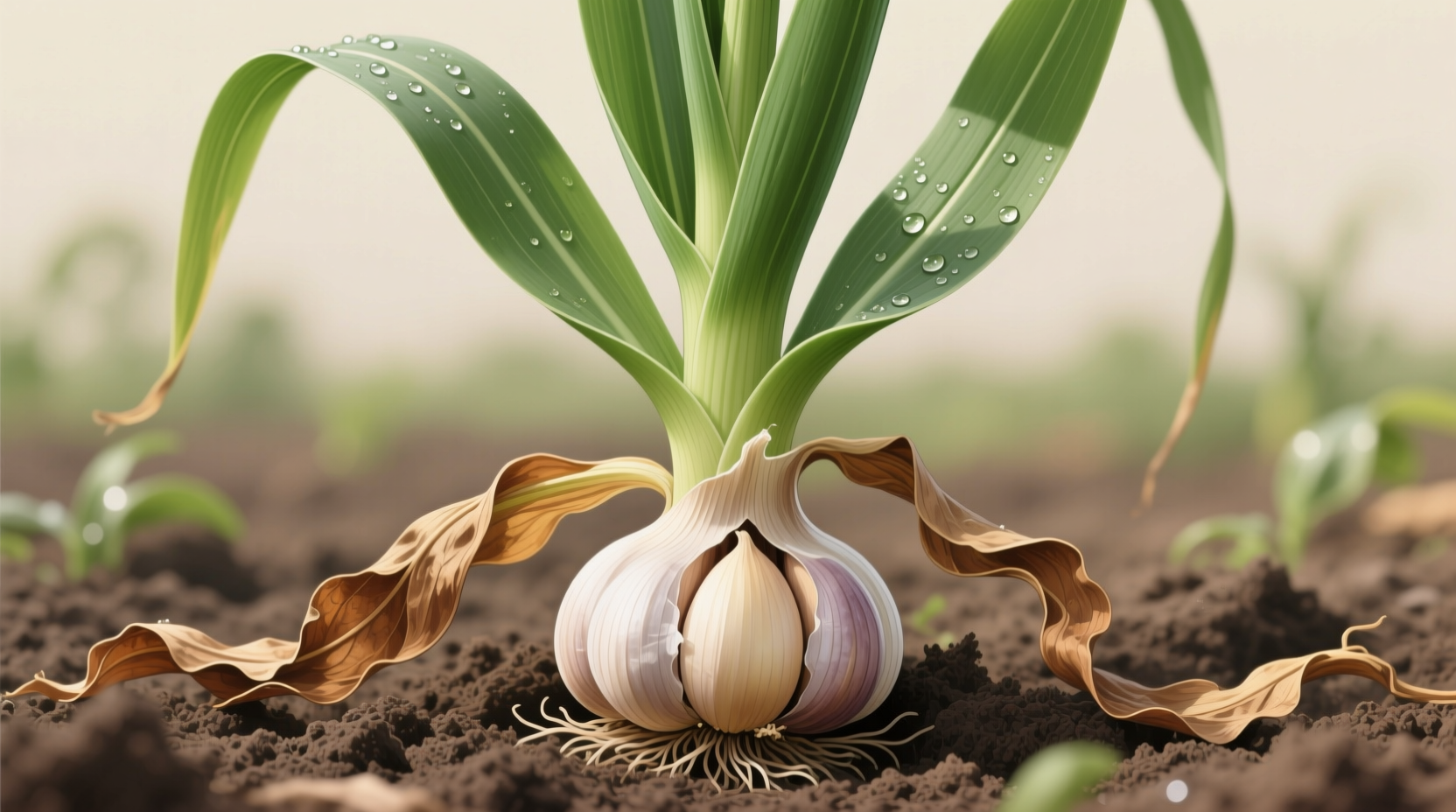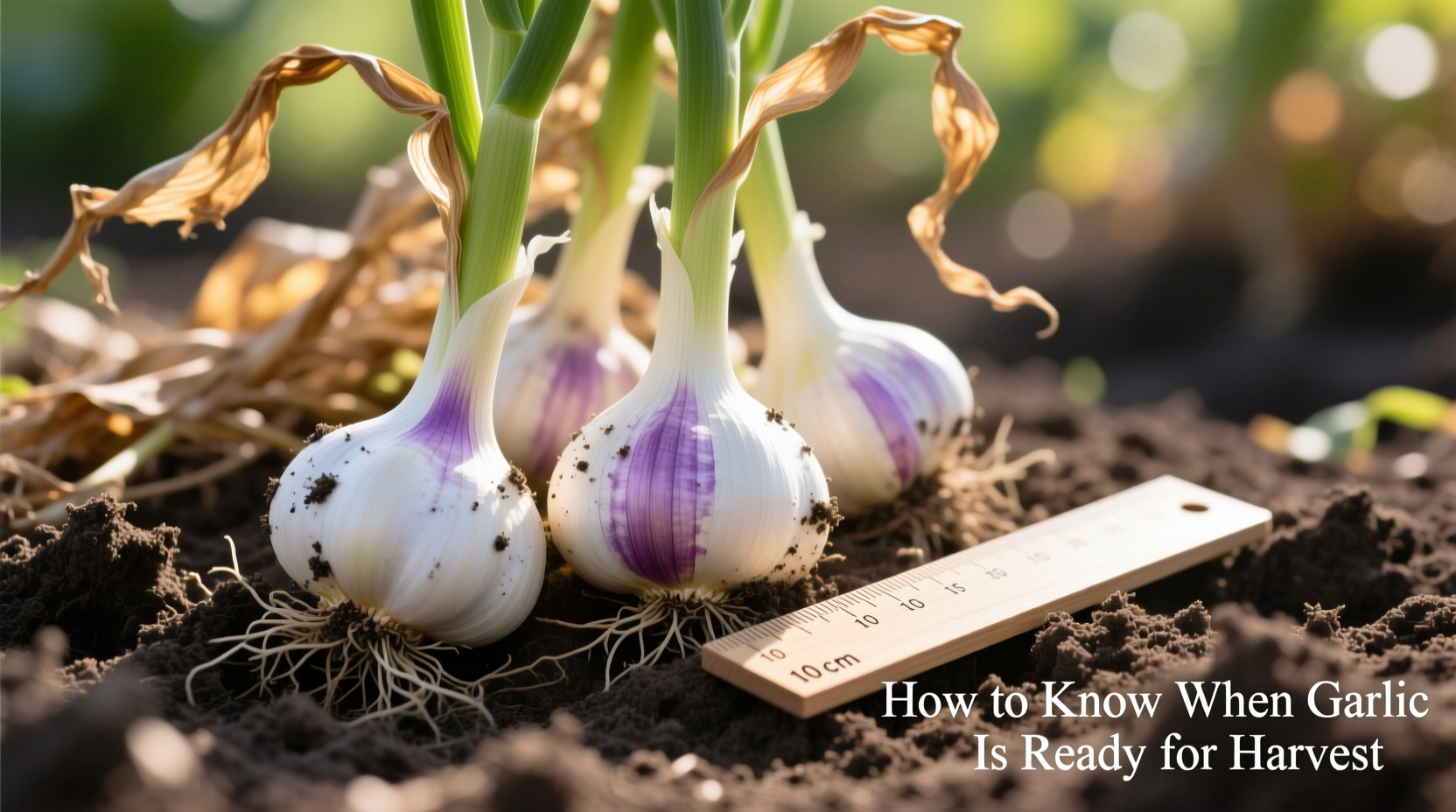Why Timing Your Garlic Harvest Matters
Harvesting too early yields undersized bulbs with thin wrappers that won't store well. Wait too long, and cloves may separate or sprout inside the bulb. The critical window lasts just 7-10 days—missing it compromises both size and shelf life. Commercial growers using precision timing achieve 30% larger bulbs than home gardeners who guess, according to University of California Agriculture research.

3 Visual Indicators That Signal Perfect Harvest Time
Don't rely on calendar dates alone—your garlic's physical cues are the true indicators. Watch for these progression signs:
1. The Leaf Die-Off Progression (Your Most Reliable Gauge)
Count the green leaves remaining on each plant. When 40-50% of leaves turn brown starting from the base, harvest is imminent. This typically occurs when 5-6 green leaves remain on hardneck varieties. The Cornell Cooperative Extension confirms this leaf ratio correlates directly with bulb maturity across all climate zones.
| Garlic Type | Key Harvest Indicator | Typical Harvest Month* |
|---|---|---|
| Hardneck (Rocambole, Porcelain) | 5-6 green leaves remaining; scape straightens after curling | June-July (Northern Hemisphere) |
| Softneck (Silverskin, Artichoke) | Lower 1/3 leaves brown; top leaves still flexible | July-August (Northern Hemisphere) |
*Varies by climate zone; see Context Boundaries section
2. Bulb Wrapper Integrity Check
Gently brush soil from the top of a test bulb. The outer wrappers should be dry, papery, and intact—not slimy or translucent. If wrappers are deteriorating, harvest immediately even if leaves aren't fully browned. This prevents soil contact that causes rot during storage.
3. Clove Definition Test
Squeeze the bulb area through the soil. Mature bulbs feel firm and segmented with distinct cloves. Immature bulbs feel like a single soft mass. This tactile check complements visual indicators, especially in wet seasons when leaf die-off accelerates prematurely.
Climate-Specific Harvest Timing Adjustments
Garlic maturity varies significantly by region. These context boundaries prevent misjudgment:
- Cool climates (Zones 3-5): Harvest 2-3 weeks later than calendar suggests. University of Maine trials show delayed harvest increases bulb size by 22% when soil temps stay below 75°F (24°C).
- Warm climates (Zones 7-10): Harvest 10-14 days earlier. Utah State University Extension documents how high heat accelerates wrapper deterioration, requiring earlier harvest.
- Excessive rain: Harvest 5-7 days sooner. Saturated soil triggers premature wrapper breakdown even with green leaves.
Step-by-Step Harvest Protocol
Follow this sequence for undamaged bulbs:
- Test first: Dig 2-3 plants to verify bulb maturity before harvesting the entire patch
- Choose dry conditions: Wait 5-7 days after rain for optimal soil workability
- Lift carefully: Use a digging fork 6 inches from plants to avoid piercing bulbs
- Preserve wrappers: Never pull by stems—loosen soil first to prevent wrapper loss
- Cure immediately: Move to shaded, ventilated area within 1 hour of harvest
Avoid These 3 Costly Harvest Mistakes
Based on Oregon State University Extension field reports:
- Mistake: Using calendar dates without checking leaf ratio
Solution: Track leaf browning weekly starting 30 days before expected harvest - Mistake: Leaving bulbs in sun to dry
Solution: Cure in shaded, breezy area—direct sun cooks bulbs and reduces storage life - Mistake: Washing bulbs before curing
Solution: Brush off soil only—moisture traps promote mold during curing
Post-Harvest Handling for 8+ Month Storage
Proper curing determines shelf life. Follow this timeline:
- Days 1-7: Hang in single layers in shaded, ventilated area (70-80°F/21-27°C, 70% humidity)
- Days 8-14: Trim roots to 1/4 inch and stems to 1 inch when wrappers feel crisp
- Long-term storage: Keep at 32-40°F (0-4°C) with 60-70% humidity—never refrigerate
Softneck varieties store longest (9-12 months) when cured properly. Hardnecks last 4-6 months. Check monthly for soft spots.











 浙公网安备
33010002000092号
浙公网安备
33010002000092号 浙B2-20120091-4
浙B2-20120091-4